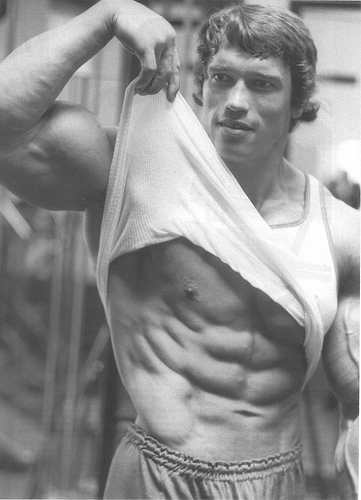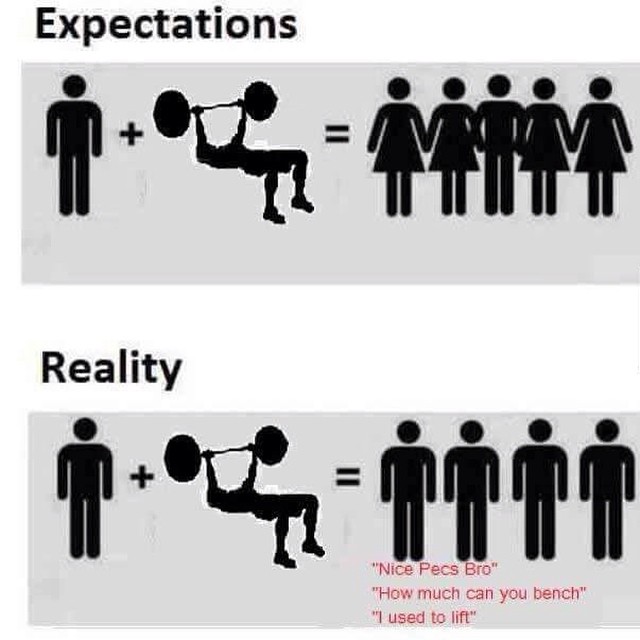Introduction: My Story
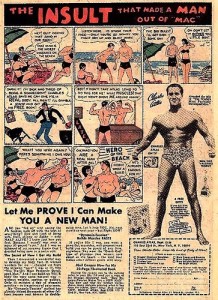
Most guys (especially younger trainees) start going to the gym with one thing in mind: building muscle as quickly as possible. I can relate to this goal–allow me to tell you a little personal history before I go any further:
I’ve been fascinated with strength and muscle since I was a kid. I remember seeing comic book advertisements from Charles Atlas during my elementary school years. I never ordered any of his programs, but the thought of having a lean, powerful physique captivated my imagination.
One of my first (embarrassing) attempts at lifting weights happened when I was about twelve years old. My cousin had begun to mess around with a weight set his parents bough him and invited me to join in. I thought I was strong, but I was unable to bench press whatever amount he put on the barbell (I think it was about 120 lb.). I asked my parents to buy a weight set for me for Christmas (or maybe my birthday) and they agreed. Soon I had my own set of concrete-filled plastic weights and would train sporadically.
My next vivid memory is from my high school years: training with “real” (Olympic-style) barbells and plates for the first time while trying out for the football team. I could barely move the day after that first workout with the team. I wasn’t very strong (being a “late bloomer” physically didn’t help), but that slowly began to change as I kept training. I never became a great football player, but I did develop a passion for building muscle and strength.
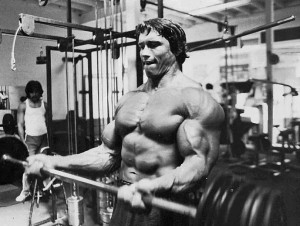
Arnold Schwarzenegger became my idol in my college years. I carefully studied both his publications on training and his pictures. He’s still my favorite bodybuilder, but I later realized he wasn’t a realistic role model for someone like me (more on that later).
I kept working out through the 90’s, experimenting with different training techniques (some worked, some didn’t). I spent way too much money on supplements, most of which did absolutely nothing (I tried almost everything the supplement industry produced: prohormones, etc.).
I’ve never competed in bodybuilding–it’s just not one of my goals or priorities in life. But I did end up building a pretty good physique, and regularly train to this day (I’m not in my 40’s).
This article is kind of a collection of things I wish I knew back when I first started training years ago. I didn’t know much about building mass and strength when I first started lifting–I learned through bodybuilding magazines, misguided coaches and other various sources. There was a lot of trial and error involved, and I’m convinced I could have made better gains in less time if I knew then what I know now. I’m hoping these tips will help new trainees avoid the mistakes I made.
Avoiding Mistakes
Here are a few things you need to avoid if you are serious about getting bigger and stronger:
Mistake #1: Spending too much money/time/energy on bodybuilding supplements.
As mentioned, I spent way too much of my hard-earned cash on bodybuilding supplements in my younger days. The vast majority of the stuff I bought didn’t do anything to help me build my physique. That money could have gone into savings or other better uses.
Here’s what you have to understand about the bodybuilding supplement industry: it exists to make money, not muscle. It is a largely unregulated business, and you’ll get ripped off quickly if your believe everything they advertise.
I’m not opposed to supplements, but you need to stick to the basics and don’t be in a hurry to try the latest, greatest products. Wait until multiple studies are done on new formulas before deciding to try or buy. More importantly, don’t expect supplements to make that much difference–your diet and training are going will be much, much more important than any pill or powder you use.
Mistake #2: Copying the Routines of Professional Bodybuilders
Some guys make the mistake of trying to train like professional bodybuilders, using routines they see in magazines. This is not a good idea for several reasons:
1. Genetics: Professional athletes of any kind are going to be genetically gifted, so what works for them may not work for you.
2. Anabolic Steroids: You can’t expect to get the same results as a guy who is taking drugs. His recovery ability will be enhanced beyond what is naturally possible, so following his routine is not advisable.
3. Fictitious Routines: You can’t even be sure that a routine printed in a magazine is the one your favorite competitor actually uses–it’s quite possible that a writer/editor just made it up.
Mistake #3 Poor Nutrition
Can you make gains on a crappy diet? Yes–I built some size and strength with a completely haphazard eating plan during my college years. But if you want to build quality mass in record time you’ll need to put just as much planning into your nutrition as your workouts. Many trainees will spend hours in the gym without putting a fraction of that time/effort into their eating plan. Remember: we are talking about building your body as quickly as humanly possible–that won’t happen with poor nutrition.
How To Build Muscle Fast: The Basics
Now let’s get into the basic things you should be doing if size and strength is your goal. I won’t be sharing every detail, but this overview should get you going in the right direction.
Training
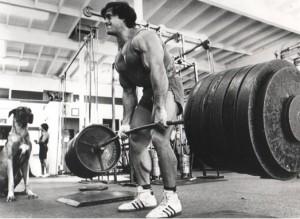
1. Build strength in the basic lifts like deadlift, bench press, squat, etc. These old-school, multi-joint movements will give you a lot of “bang for your buck,” providing a powerful training stimulus to the large muscles (back, thighs, etc.). Get stronger in these movements and you’ll be on your way to building a more massive, powerful physique. It’s fine to spend some time on isolation movements (like curls), but focus most of your time and energy on the big lifts.
2. Stick to the 5-12 rep range. You’ll find that the vast majority of your growth comes from this range of repetitions because it gives you a good balance of volume and intensity. You can experiment with higher/lower reps once you get more advanced, but stay somewhere within this range if you are just starting out. Here’s another tip: you’ll find that somewhere between 30-60 total repetitions per muscle in each workout session should be enough training stimulus for growth.
3. Train each muscle (or muscle group) twice a week. A muscle will typically recover within about 72 hours of being trained. After that you should be able to work it out again. You can get by with less frequent training, but you are missing opportunities for growth (52 opportunities per year).
Nutrition
1. Eat .75 grams to 1 gram of protein per lb. of body weight. This is plenty for building muscle, regardless of what you might read about the insane amounts of protein some bodybuilders supposedly eat. It’s fine if some of this protein comes from supplements (like whey powder), but most of it should come from “real” food: meat, eggs, etc.
2. Eat a calorie surplus–consume more calories than you are using. You’ll probably need to eat at least 17 calories per lb. of body weight in order put on weight. Some may need to eat way more than that. Here’s another tip: you may need to keep an eating journal for a few days to track what you are eating (you may be eating far fewer calories than you think you are).
3. Add extra meals (or shakes) if needed. You may find it difficult to get adequate calories/protein from only three meals a day. Eat an additional meal or drink a protein shake if needed, but don’t get caught up in thinking there is some magical number of meals a day for building muscle. Just eat as many times as you need to properly digest your protein/calorie requirements.
Supplements
As I’ve previously mentioned, I’d recommend you stick to the basics: whey protein, creatine monohydrate, a multivitamin, and fish oil. Don’t keep adding a bunch of extra supplements in hopes of getting better results. Don’t overthink your supplements while under-thinking your diet and training.
Conclusion
Those are the basics on how to build muscle fast: no hype, no “magic bullets.”
